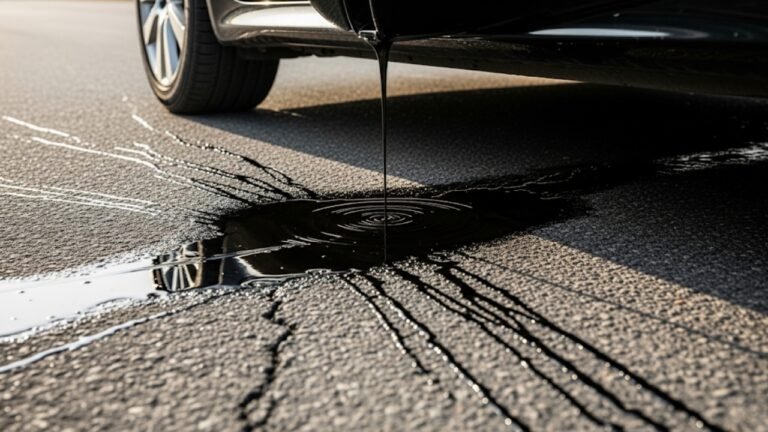Can You Put Too Much Oil in a Car?

Have you ever stood in your garage, oil bottle in hand, wondering, “Did I just pour in too much?” You’re not alone. It’s one of those things you don’t think about until it happens. Many car owners assume, “More oil means better performance,” but sadly, that’s not true. In fact, putting too much oil in a car can be just as harmful as not putting enough.
In this guide, I’ll break down exactly what happens if you overfill your engine, how to spot the warning signs, what you should do about it, and how to avoid it next time. I’ll also share a few relatable stories and simple analogies to help make this a smooth ride of learning. Whether you’re a new driver or a seasoned gearhead, this article is for you.
In This Article
- 1 Why Engine Oil Matters More Than You Think
- 2 Yes, You Can Put Too Much Oil in a Car—And Here’s the Proof
- 3 How Much is Too Much? Let’s Break It Down
- 4 What Happens If You Put Too Much Oil in a Car?
- 5 Symptoms of Too Much Oil in Your Car
- 6 How to Check If You Overfilled the Oil
- 7 What Should You Do If You Put Too Much Oil in Your Car?
- 8 Tips to Avoid Overfilling in the Future
- 9 The Long-Term Risks of Overfilling Oil
- 10 Busting Myths Around Overfilling Engine Oil
- 11 FAQs: Can You Put Too Much Oil in a Car?
- 11.1 1. What should I do if I added too much oil?
- 11.2 2. Can too much oil damage the engine?
- 11.3 3. How much oil is too much in a car?
- 11.4 4. Can I drive a short distance with too much oil?
- 11.5 5. Will an oil light come on if there’s too much oil?
- 11.6 6. What happens if you overfill by 1 quart?
- 11.7 7. Can too much oil cause a car to smoke?
- 11.8 8. Does overfilling oil void my warranty?
- 12 Cultural Note: A Lesson From a Village Mechanic
- 13 Printable Checklist: Preventing Oil Overfill
- 14 Final Thoughts: A Small Mistake That’s Easy to Avoid
Why Engine Oil Matters More Than You Think
Think of engine oil as the blood of your car. It keeps everything running smoothly, cools moving parts, and reduces wear. Without it, your engine would seize up faster than an overheated laptop.
But just like too much blood pressure in your veins can cause health problems, too much oil in your car can cause pressure issues inside the engine. It leads to damage you won’t see—until it’s too late. Balance is everything.
Here’s what engine oil does:
-
Lubricates moving engine parts.
-
Cools the engine by reducing friction.
-
Cleans out dirt and debris.
-
Protects against corrosion.
Too little? The engine overheats. Too much? It chokes. Weird, right?
Yes, You Can Put Too Much Oil in a Car—And Here’s the Proof
Let’s get this straight: Can you put too much oil in a car? Yes, you absolutely can. And it’s a surprisingly common mistake—especially among DIY oil changers.
Overfilling your oil reservoir causes the oil level to rise above the maximum mark on the dipstick. That might not sound like a big deal, but here’s what actually happens under the hood:
-
The crankshaft dips into the oil.
-
It whips it into a frothy foam.
-
That foam can’t lubricate anything.
-
Your engine starts gasping for smoothness.
-
Damage begins—silently, relentlessly.
In short, you’re drowning your engine in its own life juice. Scary, isn’t it?
How Much is Too Much? Let’s Break It Down
Overfilling a little might not wreck your car, but a consistent or heavy hand with the oil can be trouble. Let’s get specific.
Safe vs Dangerous Oil Levels
| Engine Capacity | Recommended Oil Volume | Danger Zone (Too Much) |
|---|---|---|
| 4-Cylinder | 3.5 to 4.5 quarts | Over 4.8 quarts |
| 6-Cylinder | 4.5 to 5.5 quarts | Over 6 quarts |
| 8-Cylinder | 5.5 to 7.5 quarts | Over 8 quarts |
Check your owner’s manual—always. It’ll tell you exactly what your engine needs. If you’re going even half a quart over, it’s wise to drain some out.
What Happens If You Put Too Much Oil in a Car?
Now to the heart of the matter. Let’s break down what can happen if you overfill your oil. Some of it happens fast. Some sneaks up like a bad cold.
1. Oil Foaming and Aeration
Too much oil causes the crankshaft to churn it into foam. This air-filled oil can’t properly lubricate engine components. Imagine using bubbly water to grease a squeaky hinge—it just doesn’t work.
2. Loss of Oil Pressure
You’d think more oil means more pressure, right? Actually, it often reduces pressure because of foam and air pockets. That leads to engine parts rubbing together unprotected. Ouch.
3. Engine Misfire and Plug Fouling
Excess oil can seep into spark plugs. Once soaked, spark plugs fail. Your engine will run rough, misfire, or not start at all. Trust me—I’ve had this happen after a rushed oil change. It took hours to clean up.
4. Catalytic Converter Damage
Oil leaks into the combustion chamber, gets burned, and sends oily smoke through your exhaust. Over time, your catalytic converter—an expensive and essential part—gets ruined.
5. Blown Seals and Gaskets
The pressure from extra oil can blow out gaskets and seals. Those are the things keeping fluids inside and dirt out. Once they fail, you’re in for oil leaks, overheating, and a pricey fix.
Symptoms of Too Much Oil in Your Car
Don’t panic if you think you overfilled your engine. But don’t ignore it either. Here are signs that you’ve added too much oil.
-
Blue or white exhaust smoke
-
Smell of burning oil
-
Oil leaks under the car
-
Poor engine performance
-
Check Engine Light is on
-
Rough idling or engine knocking
If you see more than one of these signs, stop driving and check your dipstick.
How to Check If You Overfilled the Oil
Here’s how to be sure. You don’t need a mechanic—just a cloth and five minutes.
-
Park your car on level ground.
-
Turn off the engine and let it cool.
-
Pop the hood and pull out the dipstick.
-
Wipe it clean, reinsert, and pull it again.
-
Look at the oil line. If it’s above “MAX,” you’ve got too much.
If it’s just a hair above the max, you might be okay short term. But if it’s significantly over—half an inch or more—you should act fast.
What Should You Do If You Put Too Much Oil in Your Car?
Let’s say it’s too late—you’ve overfilled. Don’t beat yourself up. It happens. Here’s what to do:
1. Drain the Excess Oil
Use the drain plug under the oil pan. Let out a little at a time. Measure, check the dipstick, and stop when you hit the right level. If you’re not confident, any mechanic can help for cheap.
2. Use an Oil Extractor Pump
This is cleaner and simpler. Just insert the pump into the dipstick tube and suck out the extra oil. This method avoids crawling under the car.
3. Check Again and Run the Engine
Once the level looks good, start the car. Let it run for 5 minutes. Recheck the dipstick. Add a tiny bit if needed—but don’t overdo it again.
Tips to Avoid Overfilling in the Future
We all mess up once. The key is learning from it.
-
Always read your manual before changing oil.
-
Measure oil in quarts or liters as you pour.
-
Add slowly, in stages. Check the level mid-fill.
-
Use a funnel to avoid spills and misjudgments.
-
Change oil when the engine is warm, not hot.
A little patience now saves a big headache later.
The Long-Term Risks of Overfilling Oil
You might be thinking, “Okay, I’ll fix it later. It’s just a bit extra.” But like skipping a dentist appointment, small neglects can lead to painful costs.
Over time, too much oil in a car can silently destroy your engine’s internal harmony. Here’s how the damage builds:
1. Worn Engine Bearings
Extra oil adds resistance to engine motion. Bearings—those little rings that allow your crankshaft to spin—get overloaded. They wear out faster, and once they go, it’s game over.
2. Sludge Formation
Overfilled engines often run hotter due to oil aeration. Heat plus oil breakdown equals sludge. This tar-like goo clogs passages and causes slow oil circulation.
3. Turbocharger Damage (For Turbo Engines)
If your car has a turbo, listen up. Excess oil can flood the turbocharger, damaging seals and causing oil leaks into the intake system. You’ll notice decreased performance—and a hefty repair bill.
4. Poor Fuel Economy
Foamy oil increases drag inside the engine. Your car works harder, and you pay more at the pump. Ironically, overfilling oil makes your car run less efficiently.
Busting Myths Around Overfilling Engine Oil
Let’s clear up a few myths I’ve heard from car guys at tea stalls, roadside workshops, and even a few uncles who “know cars”. Some of these could mislead even the best of us.
Myth 1: “More oil means better protection.”
Nope. Like too much water in a rice cooker, it spills and spoils everything. The engine needs just enough—not more.
Myth 2: “The engine will burn off the extra oil.”
While some oil might get burned off, not all engines consume oil quickly. You could be doing real damage while waiting for nature to “fix” it.
Myth 3: “It’s better to overfill than underfill.”
Neither is good. But honestly, underfilling by a small amount is safer than overfilling. Overfilled oil causes pressure problems. Slightly low oil just shortens lubrication time—not as damaging if caught early.
Myth 4: “My mechanic topped it up, so it must be fine.”
Even mechanics make mistakes. Always double-check your dipstick before driving away. Trust, but verify.
FAQs: Can You Put Too Much Oil in a Car?
Here are answers to some of the most asked questions on this topic. If you’re still unsure, these should clear the air.
1. What should I do if I added too much oil?
Stop driving. Let the engine cool. Then use a pump or remove the drain plug to remove the excess. Check your dipstick until the level sits just below “MAX.”
2. Can too much oil damage the engine?
Yes. It causes foaming, pressure loss, blown gaskets, and even misfires. It may ruin your catalytic converter too, which is very costly to replace.
3. How much oil is too much in a car?
Anything over the “MAX” mark on your dipstick is too much. In most cars, even 0.5 quart (0.5 liters) over can start causing problems.
4. Can I drive a short distance with too much oil?
If it’s slightly over the line, and you absolutely must drive, keep it to a very short distance. But any significant overfill should be corrected before driving again.
5. Will an oil light come on if there’s too much oil?
No. The oil light usually comes on when there’s low oil pressure—but ironically, too much oil can cause pressure loss too. So by the time the light comes on, damage may already be done.
6. What happens if you overfill by 1 quart?
That’s a lot. It will cause foaming, overheating, and can lead to seal damage. You need to drain that extra quart as soon as possible.
7. Can too much oil cause a car to smoke?
Yes. Burnt oil creates blue or white smoke from your exhaust. It’s a clear sign oil is getting into the combustion chamber or exhaust.
8. Does overfilling oil void my warranty?
In many cases, yes. Manufacturers consider this a maintenance error. If engine damage occurs from overfilled oil, you may not be covered.
Cultural Note: A Lesson From a Village Mechanic
Let me take you back to a dusty workshop in rural Mymensingh. I once saw a village mechanic, barefoot and wise, tell a customer, “Joto tel tar beshi bhalo na, bujhla na re bhai?” (Too much oil isn’t good, my brother.)
That customer had overfilled his Toyota Premio. The engine ran rough, smoked like an old train, and finally gave up. It cost him more than an engine—it cost him his daily ride to work.
What I learned that day? Even the most basic engines need balanced care. And sometimes, local wisdom is ahead of the curve.
Printable Checklist: Preventing Oil Overfill
Here’s a quick checklist to keep in your glove box or hang in your garage.
- Check your owner’s manual for correct oil quantity
- Use a funnel when adding oil
- Add oil slowly and gradually
- Always use the dipstick to measure after pouring
- If unsure, consult a mechanic before starting the engine
- Never overfill “just in case” — trust measurements
- Watch for symptoms: smoke, leaks, engine noise
- Drain or extract excess oil immediately if overfilled
Final Thoughts: A Small Mistake That’s Easy to Avoid
At the end of the day, can you put too much oil in a car? Yes—and it’s one of the most overlooked but damaging mistakes car owners make.
The good news? It’s also one of the easiest to prevent.
Treat your car like a living thing. Give it what it needs—but no more. Just like we don’t eat five meals at once thinking it’ll last us a week, your engine doesn’t need “extra care” in the form of too much oil.
When you take time to do it right, you protect your car’s future—and your peace of mind.






